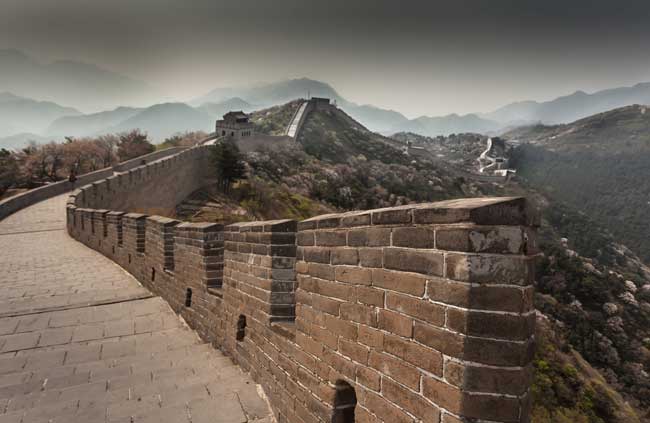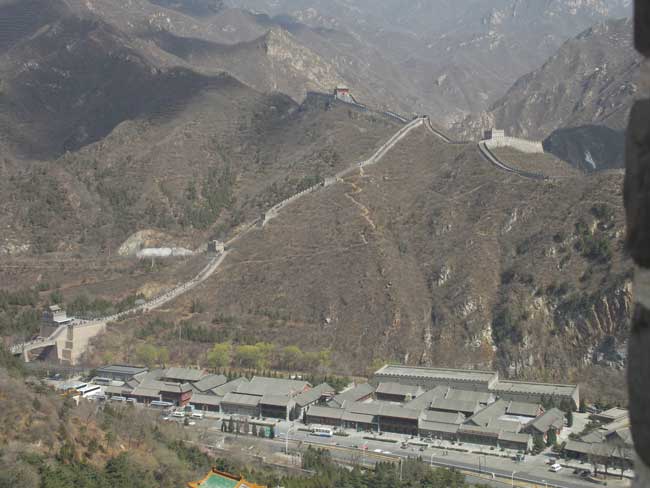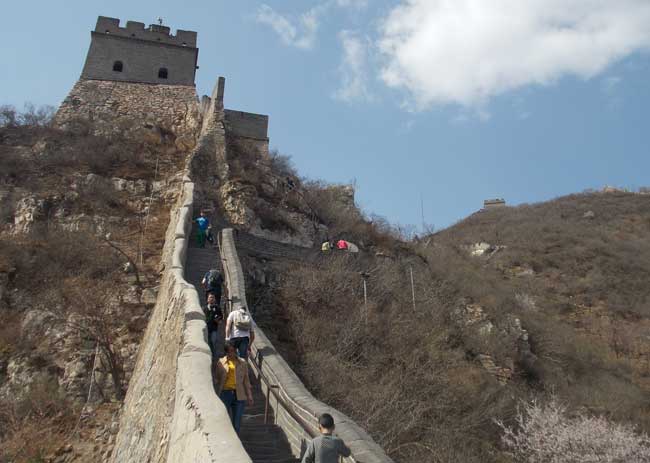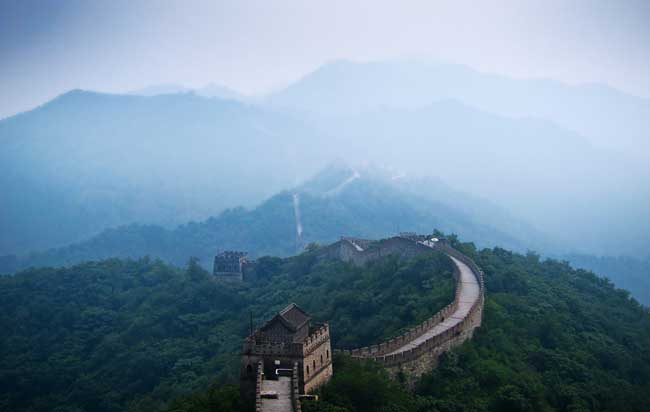

There’s been a lot of talk in the news lately about building great walls to protect borders. But border walls are nothing new.
And one of the biggest, farthest-reaching, and oldest border walls designed to keep outsiders outside is just outside Bejing, China.
Recently, during our travel in China, my daughter and I took a walk along part of the Great Wall of China.
Visit the Great Wall of China
Like most who visit the Great Wall of China, Nicole and I made our base in Beijing. Locals in Beijing say that if you look to the sky and see blue, you should play your lo\ttery numbers.
Pollution has made air conditions harsh, and the forecast on most days — rain or shine — is smoggy.
That wasn’t the case on the morning that we left the busy city of Beijing for one of the most visited tourist attractions of China — and the very symbol of the ancient nation’s resolve to protect itself from the outside world.
Impressive View
When we arrived by bus to the Great Wall of China, we found it to be as impressive as we imagined it would be — and we only saw a tiny portion of it.
“Tiny” didn’t seem like the right adjective at the time, however, as we approached and proceeded along a portion of the great stone walkway.

The full wall snakes through the mountains and valleys of foliage and desert for thousands of miles. The Great Wall originated as a series of individual walls.
But between 221 and 210 B.C., a unified China unified the wall, fortifying the smaller walls already there and connecting them with more wall. Today, it continues to stand as the largest man-made structure in the world.
The genius of the wall was not that it was so tall and strong. It’s that every single section of the wall is within reach of a bowman’s arrow from a tower, meaning that no part of the wall went unprotected.
The Ancient-Messaging App: Towers
The towers also served as beacons, so it made for an easy and fast way to send an alert from one part of the wall — or China — to another.
Messages could be sent quickly from one tower to another by fire, smoke, flares, drums, or bells.
“Like an ancient instant-messaging app,” our guide offered, cell phone in hand.
The wall also offered a means of base and protection for troops traveling from one part of China to another. Camp always remained permanently set just beside the wall.
We felt something like troops ourselves as we sweated our way up the wall at Juyong Pass, the most popular section of the wall for tourists due to its proximity to Beijing.
We climbed narrow and uneven stairs built centuries ago. We made it up through three towers, the crumbling stairs extremely steep and uneven.
The railings were so low that only the smallest children could take advantage of them — unless you decided to crawl. It took a lot of effort and energy to walk the wall, even just for a couple hours.
Having a Good Guide
It’s a good thing our guide reminded us earlier that morning to wear good footwear (hiking shoes), and gave us water bottles to carry with us as we went.
Those bottles were empty by the time we made it back down the wall.
We climbed to the top of one of the watchtowers. To get to the top, we had to navigate extremely narrow stairs that were so steep we had to use our hands and feet at the same time, balancing ourselves as we went up and down.
They were more like stone ladders than stairs.

The most challenging part of the wall hike was coming back down. It seemed dangerous, and the slightest slip could send you tumbling down what looked like an endless decent.
View from the Top
The view from atop the great wall was absolutely alluring and made it worth the risk and effort. We took in the blue sky, the mountains in the distance, trees, and nature surrounding us.
The wall took advantage of the natural terrain of the hillside, meaning that wherever you stood on the wall, you got the best view in the area.
The best view of all: the snaking back and forth of the wall itself through the mountainous distance.
Even the birds chirping in the breezy trees above us were probably singing the praises of the panoramic views offered by the Great Wall of China.
As a bird landed on the wall’s stone edge, I imagined their calls to one another from one watchtower to another — a love song spreading for thousands of miles.

How to Reach the Great Wall of China
The Great Wall of China is huge, but it’s easy to invade China and take a leisurely stroll along it. The most popular section of the wall for visitors is the Juyong Pass area, about 37 miles from Beijing.
The easiest way to get there is by tour bus, and if you book your trip to China through a package deal or a company specializing in China tours, you’ll most certainly be offered one.
If you prefer to “rough it,” you can also make it to Juyong Pass by public bus or train. Take the Beijing subway line 13 to Longze Station.
From there, hop on bus line Chang 19, 21, or 58 or Zhuan 53, 519, or 878 to Shahe Station. Or you can depart from the Deshengmen West Station by bus to Shahe Station.
From Shahe Station, take bus Chang 68 to Juyong Pass.
Traveling in Train
If you prefer to travel by train, take the Beijing subway line 2, 4, or 13 to Beijing North Railway Station. From the train station, take train S2 to Badaling Railway Station.
From Badaling, you can take a free shuttle bus to the Badaling Bus Station and catch bus 879 to Juyong Pass.
It’s easier than it sounds, but you can see why many westerners opt to get a group or private tour, which you can do for as little as $30 with a group, $50 for a private half-day tour, or $100 for a full day tour.
In these cases, your bus will pick you up at your hotel or an easily accessible place, and drop you off there at the end of the adventure.
Be sure to bring snacks as there aren’t many food options on site, and bring a few water bottles to stay hydrated.
The stairs can be steep and narrow, so watch your step while you’re watching the view.

Author Bio: Eric D. Goodman enjoys traveling as much as he loves writing. His fiction and travel stories have been published in many periodicals, including Go Nomad, InTravel Magazine, Travel Mag, The Washington Post, and The Baltimore Sun. Eric’s the author of the award-winning Tracks: A Novel in Stories about travelers who connect on a train, Flightless Goose, a storybook for children, and the forthcoming Womb: a novel in utero. Learn more about Eric and his work at www.EricDGoodman.com and connect with him at www.Facebook.com/EricDGoodman.
- Cruising with Discovery Princess on the Mexican Riviera - March 30, 2024
- La Paz, Mexico: Pearl on the Sea of Cortez - February 26, 2024
- 9 Places to Experience Amazing Sea Life Up Close - January 26, 2024
